What is Safety?
Hospital safety refers to the set of measures, procedures, and protocols aimed at ensuring patients’ well-being and safety within a healthcare setting.
It is an essential aspect of healthcare delivery that requires collective responsibility, from administrative executives to medical professionals and supporting staff.
The concept of hospital safety has evolved significantly over the years, with a growing focus on preventing errors, managing infections, and ensuring optimal use of resources.
Ensuring hospital safety is a multifaceted endeavor that includes aspects like infection control, medication safety, patient handling, and emergency preparedness.
It also encompasses the maintenance of safe and functional facilities. Infection control involves methods to minimize the risk of healthcare-associated infections (HAI), which are infections that patients acquire while receiving treatment for other conditions.
Medication safety ensures that the correct medication is given to the right patient, in the correct dosage and at the right time.
Another critical component of hospital safety is managing patient handling to prevent falls or injuries during transfers and mobility activities.
Emergency preparedness involves planning for unforeseen circumstances such as natural disasters or pandemics that could compromise the hospital’s ability to provide care
Hospital safety is not just about protecting patients. It also includes safeguarding healthcare workers from potential harm such as occupational hazards and workplace violence. It is therefore integral for hospitals to prioritize both patient and staff safety in their operations.
In summary, hospital safety is a complex yet vital element in providing quality healthcare. It requires constant vigilance, continual improvement, and a culture of safety instilled at all levels of the health care organization.
A robust hospital safety program can significantly reduce medical errors, improve patient outcomes, and foster trust within the community it serves.
**For nurses who work in clinical settings need to guide their juniors and nursing students Essential Guide to Nursing Preceptorship is a complete guide.**
Characteristics of Safety
Safety encompasses various characteristics that contribute to preventing harm, ensuring well-being, and promoting security. Some key characteristics of safety include:
- Prevention: Safety measures are proactive rather than reactive. They aim to prevent accidents, injuries, or harm before they occur by identifying and mitigating risks.
- Risk Management: Safety involves identifying potential hazards and assessing risks associated with various activities, environments, or processes. It includes implementing strategies to manage and minimize these risks.
- Compliance: Safety often involves adherence to laws, regulations, standards, and guidelines established by relevant authorities or organizations to ensure the protection of individuals, communities, and the environment.
- Training and Education: Safety awareness and knowledge are essential. Providing training and education to individuals about safety procedures, best practices, and potential hazards can empower them to make informed decisions and take appropriate actions to protect themselves and others.
- Responsibility: Safety is a shared responsibility among individuals, organizations, communities, and governments. Everyone has a role to play in creating and maintaining safe environments and practices.
- Continuous Improvement: Safety is an ongoing process that requires regular evaluation, review, and improvement of safety protocols, procedures, and systems based on feedback, lessons learned, and advancements in technology or knowledge.
- Communication: Effective communication is crucial for promoting safety. Clear and open communication channels allow for the exchange of information about potential risks, safety procedures, emergency protocols, and relevant updates.
- Emergency Preparedness: Being prepared for emergencies is essential for safety. This includes having plans, protocols, and resources in place to respond effectively to accidents, natural disasters, or other unexpected events.
- Health and Well-being: Safety is not only about preventing physical harm but also about promoting overall health and well-being. It encompasses factors such as mental health, ergonomic design, and access to healthcare services.
- Culture: A culture of safety fosters an environment where safety is prioritized, valued, and integrated into all aspects of life and work. It involves promoting attitudes, behaviors, and norms that prioritize safety above other considerations.
These characteristics together contribute to creating and maintaining safe environments, whether it be in workplaces, communities, public spaces, or homes.
What are the Needs of Hospital Safety?
In a hospital, safety goes beyond merely preventing accidents. It encompasses a comprehensive approach to protect patients, staff, and visitors from harm.
The characteristics of hospital safety include infection control, proper handling and disposal of hazardous materials, maintenance of equipment, effective communication, and adherence to established protocols and guidelines.
Following are the key elements of hospital safety.
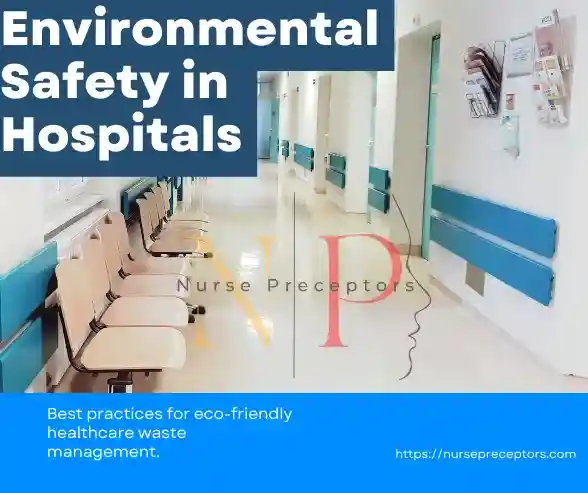
**Nurses face multiple ethical and legal issues in their practical life Understanding the Ethical and Legal Issues in Contemporary Nursing is a complete guide for professional nurses.**
What are the Methods of Infection Control in Hospitals?
Infection control and prevention in hospitals is a basic element of the safety and well-being of both patients and healthcare workers.
Hospitals are inherently vulnerable to the spread of infections due to the constant influx of sick individuals and the proximity in which they are cared for. Therefore, it is crucial to implement effective strategies and protocols to prevent and control the spread of infections within hospital settings.
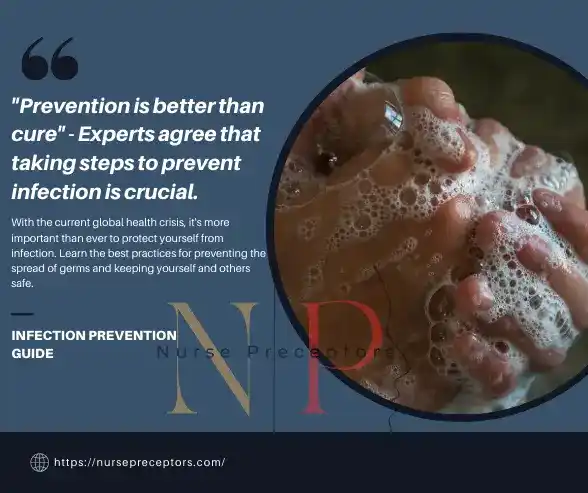
World Health Organization (WHO) has published the guidelines on hand hygiene indicating five moments of hand hygiene including:
- Before touching the patient
- Before any clean or aseptic procedure
- After touching the patient
- After any body fluid exposure risk
- After touching the patient’s surrounding
**New format of NCLEX-RN Exam could be the critical for nursing graduates. A Comprehensive Guide to Next Generation NCLEX (NGN) is an amazing guide for nurses**
Fire Safety Requirements for Hospitals
Fire safety measures in hospitals are critical to ensure the safety and well-being of patients, staff, and visitors. Hospitals are complex structures with various areas that pose different fire threats. It’s essential to have a comprehensive fire safety plan in place to prevent fires, minimize damage, and facilitate safe evacuation if necessary.
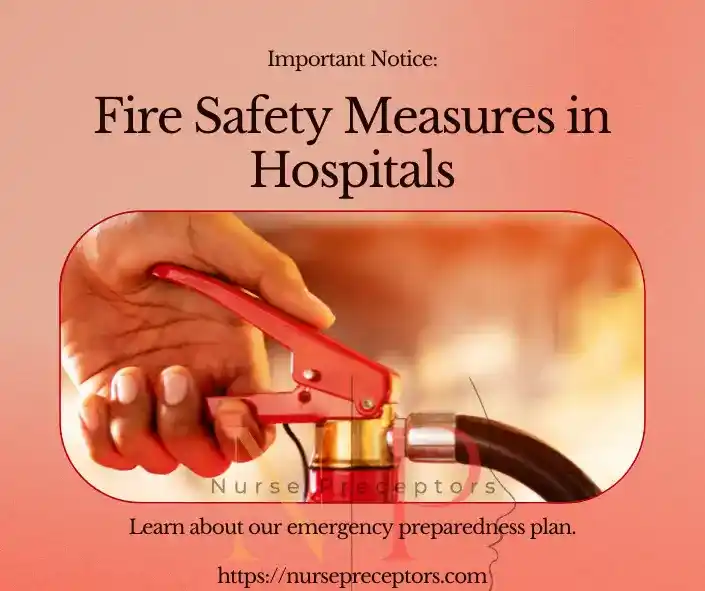
**For nursing students, complete detail about Founders of Modern Nursing who fostered the nursing practice for future nurses**
What are the Basic Radiation Protection Measures?
Radiation protection measures in hospitals are essential to ensure the safety of patients, healthcare workers, and the general public. These measures aim to minimize exposure to ionizing radiation, which is commonly used in various medical procedures such as X-rays, CT scans, and nuclear medicine.
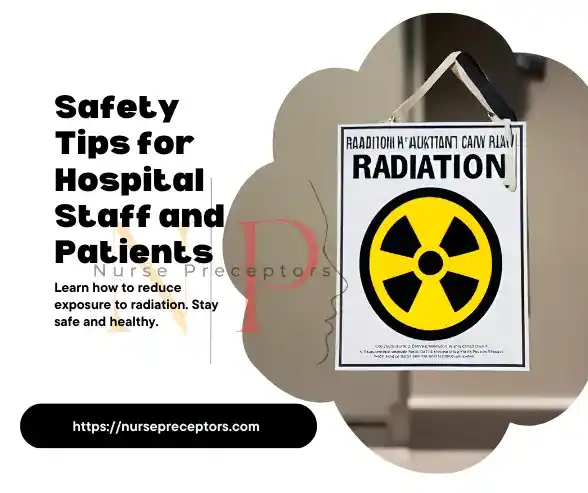
Proper implementation of TDS involves designing work areas with shielding materials, maintaining safe distances from radiation sources, and limiting the time spent in areas with high radiation levels.
In addition to time and distance, TDS also considers other factors like the type and energy of radiation, as different types of radiation require different shielding materials and techniques.
Organizations need to conduct thorough assessments of radiation hazards and develop appropriate TDS strategies to ensure the safety of workers and the public.
**If you are preparing for the NCLEX-RN Exam, learn how to use Clinical Knowledge, skills & strategies in NCLEX-RN Exam.**
What is the safety of Medication?
Medication safety in hospitals refers to the processes and measures put in place to ensure that patients receive the correct medications in the appropriate dosage and at the right time.
It encompasses various strategies implemented by healthcare providers to prevent medication errors and adverse drug events. The goal of medication safety in hospitals is to minimize the risks associated with medication use and enhance patient outcomes.
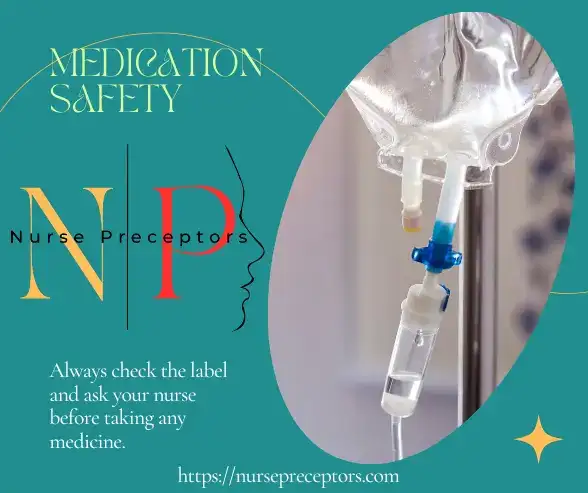
Hospital Disaster Management Plan
A disaster management plan in a hospital is a comprehensive and systematic approach to prepare for, respond to, and recover from various types of disasters or emergencies that may occur within the healthcare facility.
The primary objective of a disaster management plan is to ensure the safety and well-being of patients, staff, and visitors, while also minimizing the impact of the disaster on the hospital’s operations.
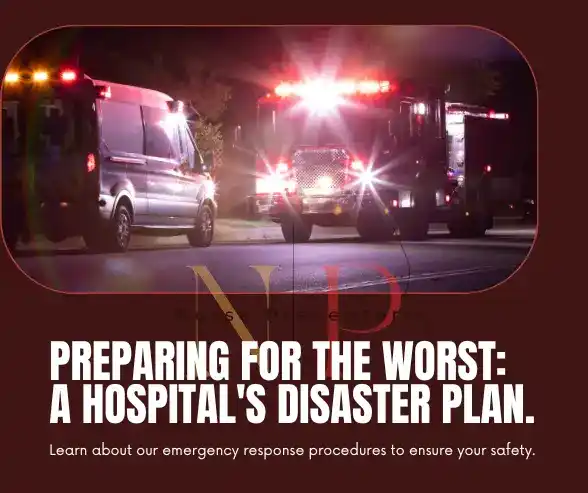
Safety of Documents and Record in Healthcare
Ensuring the safety of documents and records in a hospital setting is crucial for maintaining patient confidentiality and providing quality care. Several measures can be implemented to safeguard these important documents and ensure their integrity.

**Nursing documentation is a crucila element for the safe healthcare practices, nurses should know about the Legal Aspects of Nusing Documentation**
Near-miss and Incident Reporting
Near miss and incident reporting in hospital settings are crucial elements of healthcare quality assurance and patient safety initiatives. A ‘near miss’ refers to an event that could have resulted in harm or injury but was prevented, often just in time.
An ‘incident report’, on the other hand, documents an event that resulted in harm or had the potential to cause harm, thus necessitating a clear and comprehensive report.
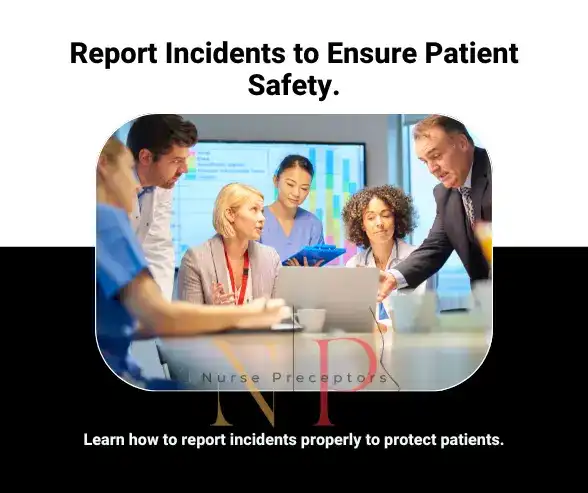
Near misses provide valuable opportunities for learning and prevention. By reporting a near miss, healthcare professionals can highlight areas of potential risk that might have otherwise gone unnoticed.
Near miss reporting can be instrumental in identifying systemic issues or gaps in training that may contribute to adverse events. It is a proactive measure to ensure patient safety, quality care, and continuous improvement.
Recognizing and addressing near misses can help prevent future incidents or adverse events.
The importance of incident reporting cannot be overstated. Incident reports are critical for tracking adverse events and identifying patterns or trends that might indicate a broader systemic issue within the hospital.
They are key tools for improving patient safety, enhancing quality of care, and mitigating litigation risks. Incident reports provide a factual account of the event, detailing the circumstances leading up to the incident, the individuals involved, the actions taken, and the outcomes.
This comprehensive documentation helps facilitate objective investigation and analysis, ultimately leading to effective corrective actions.
Risk Management and Quality Assurance in Healthcare
The role of risk management and quality assurance is paramount in ensuring hospital safety. These two interrelated disciplines play a vital role in optimizing patient safety, enhancing quality of care, and reducing errors in the healthcare system.
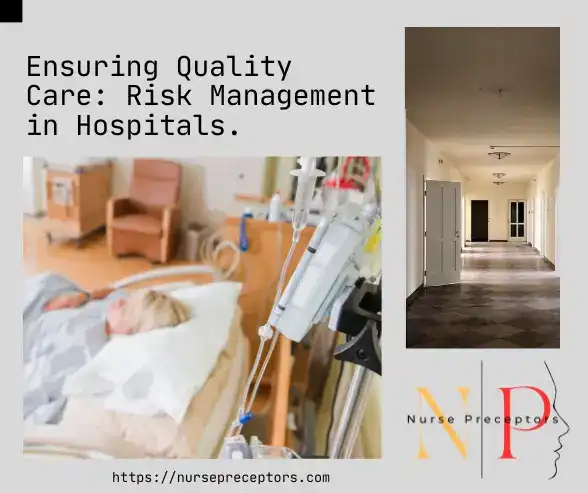
- Risk management in a hospital setting involves the identification, assessment, and prioritization of risks associated with healthcare. It is instrumental in minimizing the potential for adverse events, such as medical errors, patient injuries, or other incidents that could negatively impact patient care or hospital operations. Risk management strategies include routine safety audits, staff training, and the implementation of effective communication systems. This proactive approach assists in mitigating risks before they escalate into serious problems, thereby ensuring a safer environment for patients and staff alike.
- Quality assurance, on the other hand, is a systematic process of checking to see whether the services provided meet specified standards of care. In essence, it’s about making sure that the right things are being done in the right way. Quality assurance activities include policy and procedure reviews, performance evaluations, and improvement initiatives. These activities are designed to measure and improve the quality of care delivered to patients.
Hence, the role of risk management and quality assurance cannot be overemphasized; they are essential components in maintaining high standards of patient care and hospital safety.
The integration of both disciplines can lead to an effective safety system that is capable of identifying potential issues before they become problems, driving continuous improvement, and fostering an atmosphere of patient safety and satisfaction.
Conclusion
By implementing effective safety protocols such as hand hygiene practices, proper use of PPE, regular cleaning and disinfection, surveillance systems, and education programs, hospitals can minimize the risk of infections and create a safer environment for everyone involved.
Disaster management planning in a hospital is a crucial framework that outlines strategies and procedures for effectively responding to emergencies or disasters.
By having a well-designed and regularly updated plan in place, hospitals can ensure the safety of patients, staff, and visitors while also minimizing disruptions to essential healthcare services during times of crisis.
Safeguarding documents and records in a hospital setting requires a combination of secure storage systems, backup procedures, clear policies, cyber security measures, and staff education.
Reporting near misses and incidents in a hospital environment is crucial for improving patient safety and preventing harm. By ensuring that all staff members are aware of the reporting process, accurately documenting the details of the event, promptly reporting through the designated system, and conducting thorough investigations, hospitals can take proactive steps towards preventing future occurrences and providing high-quality care.
References:
- Berman, A., Kozier, B., Erb, G. L., Snyder, S., Levett-Jones, T., Dwyer, T., Hales, M., Harvey, N., Langtree, T., Moxham, L., Parker, B., Reid-Searl, K., & Stanley, D. (2018). Kozier and Erb’s fundamentals of nursing: Concepts, process and Practice. Pearson Australia.
- DeLaune, S. C., & Ladner, P. K. (2002). Fundamentals of Nursing: Standards & Practice. Delmar Thomson Learning.
- Potter, P. A., Perry, A. G., Stockert, P. A., & Hall, A. (2019). Essentials for nursing practice. Elsevier.
- Standard precautions in health care. (n.d.). https://www.who.int/docs/default-source/documents/health-topics/standard-precautions-in-health-care.pdf
- Centers for Disease Control and Prevention. (2018, June 18). Standard precautions. Centers for Disease Control and Prevention. https://www.cdc.gov/oralhealth/infectioncontrol/summary-infection-prevention-practices/standard-precautions.html
- ETool : Hospitals – hospital-wide hazards – fire hazards. Occupational Safety and Health Administration. (n.d.). https://www.osha.gov/etools/hospitals/hospital-wide-hazards/fire-hazards
- A complete guide to hospital fire safety by SureFire CPR. SureFire CPR. (2022, July 25). https://surefirecpr.com/fire-safety/hospital-fire-safety-guide/
- Centers for Disease Control and Prevention. (2015, December 7). Radiation studies – CDC: Radiation Safety. Centers for Disease Control and Prevention. https://www.cdc.gov/nceh/radiation/safety.html#:~:text=This%20principle%20means%20that%20even,time%2C%20distance%2C%20and%20shielding.
- Hospital disaster management guidelines. (n.d.-a). https://dhs.kerala.gov.in/wp-content/uploads/2020/08/hdmg_18082018.pdf